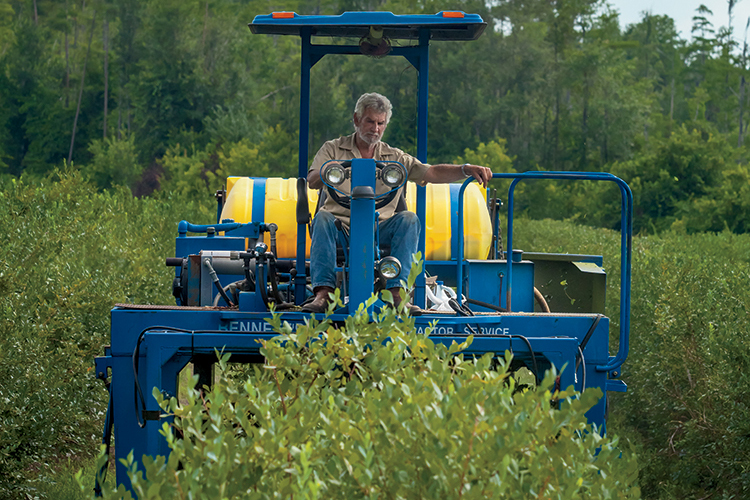Home > Georgia > Georgia Crops & Livestock > Georgia Blueberries: A Sweet Harvest
Georgia Blueberries: A Sweet Harvest

Blueberries pack quite a punch when it comes to nutrition, and Georgia farmers are taking note. As consumer demand for antioxidant-rich blueberries increased over the past decade, so has their production in Georgia – a state long known for peaches.
“Blueberry production has really blossomed in Georgia, thanks in part to the fact that we have a lot of good, sandy soil with organic matter being a key component,” says Joe Cornelius Jr., chairman of the Georgia Blueberry Commission and owner of J&B Blueberry Farms in Manor. “Georgia farmers produced 65 million pounds of blueberries in 2013, and there’s a good chance we will produce 75 million pounds in 2014. Blueberry production is going through the roof.”
Georgia’s climate is also ideal for blueberry growing, with short winters giving the berries the chilling they need and warm spring and summer temperatures perfecting their sweetness. One of the top five blueberry producing states in the nation, Georgia has the longest growing season for blueberries, lasting from late April to the end of July. Most Georgia blueberries are grown in the region south of Interstate 16 and east of Interstate 75 because that area has the best soil for the berries.
Along with his wife Brenda and adult sons, Cornelius grows 180 acres of blueberries. He plans to clear more of his timberland to expand blueberry production.
“Blueberries are a really viable industry in Georgia, not to mention they’re very healthy and good to eat,” Cornelius says.

Cogdell Berry Farm
In nearby Homerville, Russ Goodman and his father-in-law, Johnny Crumbley, own Cogdell Berry Farm, where they grow more than 500 acres of blueberries. Their farm has been in the family since 1913.
“We started growing blueberries in 2000 because their health benefits were being well-publicized, and it was a growing crop in Georgia,”
Goodman says. “We also wanted to find a way to keep my wife’s family’s land in our family. Our farm is ideally suited for blueberries because it’s near the Okefenokee Swamp, and blueberries like the organic, acidic soil.”
Blueberries are annuals, so farmers only have to plant them once, and they continue to produce year after year.
“It takes about three years before you get many berries, and we’ve seen 20-year-old blueberry plants that are still producing,” Goodman says. “We typically harvest them from mid-April through July.”
Once picked, the blueberries are placed in one-gallon buckets and carried in a refrigerated truck to a packing shed. Berries are then cleaned, sorted, weighed and graded for quality. Finally, they are packed into clam shells, shipped to distribution centers and sent to grocery stores.

Cogdell’s berries are sorted by a laser that separates ripe and overripe berries, so only the highest quality berries end up in consumers’ shopping carts.
During peak season, Cogdell has about 200 employees, including blueberry pickers, tractor operators, mechanics and those who work on the packing line.
“It’s nice to know we’re producing something that’s healthy for people … something full of antioxidants,” Goodman says. “Blueberries are brain food.”
Also part of the Cogdell team are Goodman’s wife, mother-in-law and two sons. The family grows blackberries too, and makes value-added products such as jellies, jams and ciders to sell at local farmers markets.
“The blueberry industry is full of good people,” Goodman says. “We’re part of a co-op of 300 growers, and we own it together and market together. I wouldn’t trade being part of this industry for the world.”
![Georgia Blueberry [Infographic]](https://eadn-wc01-4177395.nxedge.io/wp-content/uploads/2020/05/Screen-Shot-2014-09-30-at-4.10.38-PM.png)



